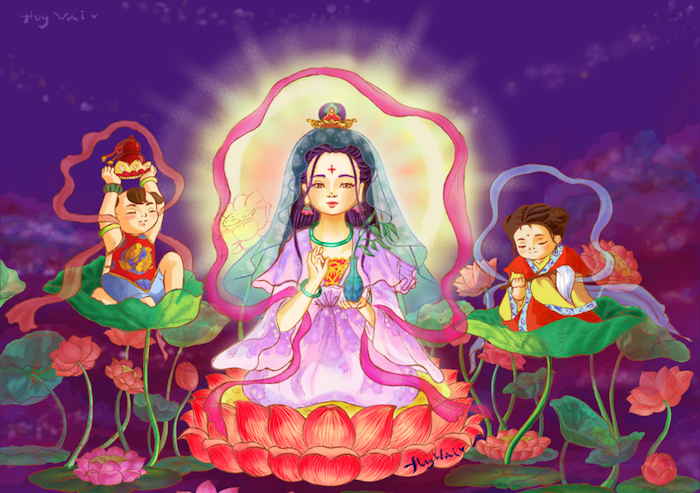How do we create a life with more love and beauty? Who doesn’t want that? The secret is realizing that it starts in the center of our own heart.
From this soft and gentle place we can learn how to generate wider and wider circles of compassion. The more our energy communicates kindness, the happier the people around us will feel, and the more beautiful our world will become.
Becoming a genuinely kinder person takes place day by day, moment by moment. By looking into our habits we bring into greater focus the balancing act of how we are taking care of ourselves and the people around us. Most of us have a tendency towards narcissism or codependency, which are actually opposite sides of the same coin of ego.
When love for self is balanced and equal with love for others, you will discover a sense of abundance and fulfillment. When everyone is feeding themselves and sharing at the same time, there is plenty to go around.
The Buddha taught the Six Paramitas as guidelines and methods for developing compassion in ordinary life. Rather than following a set of rules, I think of them as mini-practices where I can experiment with attitude shifts and behavior changes just to see what happens. The underlying motivation is for our spiritual growth. We try to avoid seeking reward or recognition from other people. It’s more like something we’re going about privately and inwardly, just to see how it changes the world around us.
Generosity
When working with generosity, we are looking for moments when we give spontaneously without any forethought (I should give. Is it okay to give? What will they think of me?) or afterthought (Why aren’t they thanking me? I deserve some appreciation!). There is nothing going on except the act of giving in and of itself.
Another aspect of generosity is offering protection from fear. There are so many ways this can go down. What I find helpful in working with people is remembering that often fear is just fear itself, another strong emotion and state of mind. Offering a compassionate presence that says, “I’m right here with you. Right now in this moment everything is okay,” can go a long way. It’s not about saving people or fixing situations in life that are un-fixable. It is about offering the comfort that says, “You’re not alone.”
Discipline
Discipline is all about training our mindful muscles so that we can work with our big feelings before they become actions and impact the people around us. We’re trying to avoid going unconscious, which means taking care of ourselves and attending to what’s going on inside when we get triggered. The thing to remember is that no matter what the issue is, when we approach the world from a place of calm and centered clarity, the world responds better to us. People hear what we are saying and are less defensive. Discipline for me has to do with not going “off duty” in the sense of conscious self awareness.
Patience
Patience means slowing down our reactivity and not taking everything so personally. Learning about patience from the Buddhist perspective was somewhat revolutionary for me. I was so caught in a fight or flight response that I hadn’t realized how with many of the smaller hurts that happen in life you can learn to stay and feel the hurt. You don’t have to do anything. By staying present and curious about what just happened, we might get more information. People who are acting out in hurtful ways are doing so from their own wounding. Sometimes they are wanting us to feel like they do inside. It doesn’t mean we should override our own feelings or jump to try to help and forgive. It’s more about experimenting with what happens if we don’t react and making conscious choices for how to respond.
Diligence
We all know what it feels like to be around people who are fully embodied and alive. Brené Brown calls them “wholehearted people.” I think of some of the Tibetan teachers I have known who have an awakeness that never seems to shut off. The practice of diligence is more about an attitude shift rather than a specific action. We’re learning how to take everything that happens as our practice and engage our life with some appreciation for the good, the bad, and the boring.
Meditation
This is about doing the practice—sitting down everyday, watching our breath, and letting our thoughts go. I went through a phase where I thought since I was doing all these other meditative activities that I didn’t need to do the formal practice. I started to feel that spiritually I was living on life support rather than being totally plugged in to the inner resources that were truly nourishing me. It’s worth trying just to see for yourself what happens when you do the practice everyday, even if just for a short session. I think you will discover how the continuity of the daily practice helps you in ways you hadn’t imagined.
Prajna
The practice of prajna is about realizing and connecting with our true nature in a very personal way. The reality that we are already free, pure, and whole just as we are in this moment is important to emphasize and contemplate because it so easily gets skipped over as we get caught in endless pursuits of self improvement. We keep trying to reinvent ourselves to be better, more spiritual, more healed, more whatever, but we never quite get there. We may even have powerful experiences of openness and think we have “awakened,” but then we lose touch with the ecstasy and fall into despair. Prajna is beyond all of that. It is the one ultimate truth that never changes, is totally indestructible, and that we all share.
Relephant:
Prajna: Our Greatest Ally & Inner Guide.
~
Author: Tina Fossella
Editor: Travis May
Photo: Deviant Art











Read 0 comments and reply